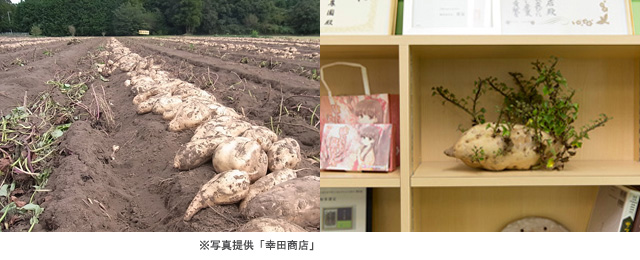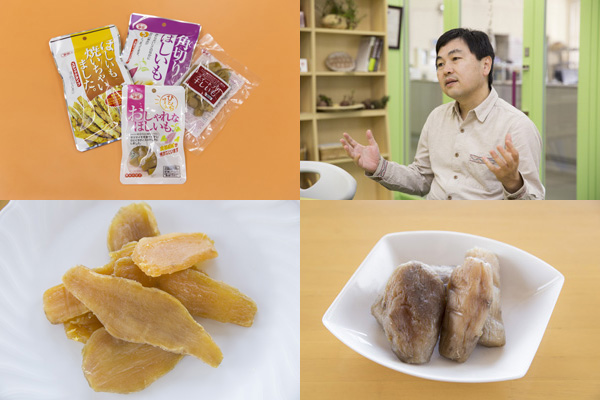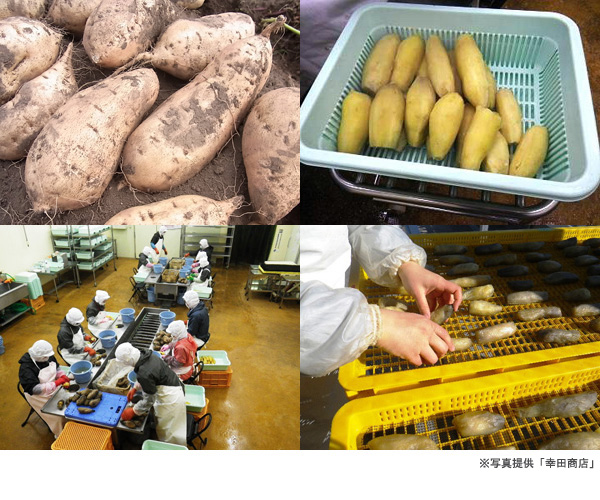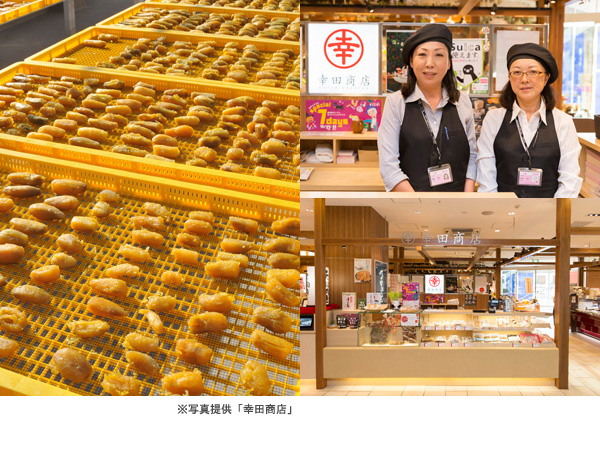Hoshi-imo (Dried Sweet Potato): A Traditional Japanese Preserved Food
Nov 08,2013
Hoshi-imo (Dried Sweet Potato): A Traditional Japanese Preserved Food
Nov 08,2013

Our ability to obtain fruits, vegetables, and seafood regardless of the season is a very recent phenomenon. Before modern refrigeration and transportation technologies, people had no choice but to eat what was available at the time.
People living in temperate regions, where fresh food is available throughout the year, can depend on seasonal produce alone. But in many parts of the world, due to climate or topography, it is hard to secure food for long periods during the year. This necessity drove people to develop preserves. A wide variety of techniques, such as fermenting, drying, or smoking perishable foodstuffs, are used to make preserves. Even today, many kinds of preserves are being formulated and produced all over the world.
This series is a journey that explores the mastery of preserves and the wisdom of everyday living, which form the foundation of food cultures. Our fifth installment takes a deep dive into hoshi-imo, dried sweet potato slices, a snack that has been treasured for decades.
▶Shuto (Fish Innards Pickled in Salt): A Traditional Japanese Preserved Food
▶Katsuobushi (dried bonito flakes): A Traditional Japanese Preserved Food

Photo courtesy of Kouta Shoten
The process of making hoshi-imo is rather simple: After steaming the sweet potatoes, slice them thinly and dry them. The only ingredient you need is sweet potatoes. No additives or preservatives are used, and no cooking with any fat or oil is necessary. The steamed slices are first dried in the sun and then completed in dryers — a procedure that ensures 100 percent of the sweet potato’s goodness is utilized.
Hoshi-imo are packed with nutrients. One 150-gram bag contains about half of the recommended daily iron intake for adult women. That bag is also full of potassium (about 90 percent of the recommended daily intake) and Vitamin E and magnesium (each about 25 percent of their respective recommended daily intake) as well as being rich in dietary fiber with zero cholesterol. Hoshi-imo, along with dried persimmons (hoshi-gaki) and sweet roasted chestnuts (amaguri), are healthy natural Japanese preserves.
The history of hoshi-imo is surprisingly brief, dating back to around 1892 during the Meiji period (1868 to 1912). It is said that the method of steaming and drying hoshi-imo was developed in what is now Iwata, Shizuoka. Sweet potatoes were first produced in Kagoshima prefecture about 300 years ago. Sweet potatoes were not transported very far at the time because they were easily damaged. Which means people in northern Japan, where sweet potatoes cannot be grown, probably first tasted sweet potatoes only after hoshi-imo began being widely distributed.
Today, Ibaraki prefecture accounts for more than 90 percent of the country’s hoshi-imo production, even though the area is at the northern extreme of where sweet potatoes can be cultivated. Why Ibaraki dominates the industry can be chalked up to its black soil, ideal for growing sweet potatoes, the strong northeasterly winds that are optimal for drying hoshi-imo, and region’s promotion of hoshi-imo production.
For this article, we visited Kouta Shoten, a specialized hoshi-imo producer. The company, founded in 1948, is located in the Mecca of hoshi-imo — Hitachinaka, a town skirting the edge of the Pacific Ocean.

Photo courtesy of Kouta Shoten

After asking Kouta Shoten to tell us about hoshi-imo — a staple, old-fashioned snack, no less than the President and CEO, Onizawa Hiroyuki, greeted us and answered our questions.
“Have you seen hoshi-imo in drugstores and convenience stores lately? That’s our doing, you know. [laughs] Until about 10 years ago, Ibaraki-produced hoshi-imo was a seasonal product, available only between September and March, and it was distributed to consumers via fruits and vegetables channels. Then about 10 years ago, we changed course and began trying to get people to eat hoshi-imo year-round as a healthy snack.”
Distributing hoshi-imo through fruits and vegetables channels means it is handled in the same way as supermarket fruits and vegetables. Unfortunately, the product wasn’t reaching younger people through these channels. So Kouta Shoten began developing inexpensive trendy products (top left photo below) that can be placed in convenience stores.
“We set up our own processing facility in China to ensure inexpensive, top-quality ingredients for these products. We have developed baked hoshi-imo products, products coated in white chocolate, stick-type products, and bite-sized products. With these options on the shelves, younger generations are far more receptive to hoshi-imo today.”
At the same time, Kouta Shoten remains committed to producing classic hoshi-imo products domestically.
One example is Bekko Hoshi-imo (bottom left photo below), which took the top prize at the 2010 Hoshi-imo Agricultural Fair, a branded product made with a variety of sweet potato called Izumi 13. Although slightly more expensive than more common Tamayutaka variety, Izumi 13 makes Bekko Hoshi-imo sweeter, stickier, and, most of all, look beautiful with its shiny golden yellow body.
Tasting Bekko Hoshi-imo, one immediately notices the juicy sensation, much like eating a tropical fruit, as well as the richly concentrated umami of the potato.


Photo courtesy of Kouta Shoten
As we mentioned at the beginning, making hoshi-imo, which uses 100 percent sweet potato, is quite simple.
The sweet potatoes harvested from the company’s farms are first cleaned and steamed before being peeled, sliced, and dried. These operations turn one kilo of sweet potatoes into 200 grams of hoshi-imo. In other words, the sweet potato is reduced to just one-fifth of its weight.
Processing sweet potatoes necessarily involves a lot of manual work, since each potato is a different shape. But it is precisely this human interaction that lends the hoshi-imo flavor a hint of the warmth of human hands.
“Japanese cuisine has been added to the UNESCO Intangible Cultural Heritage List, and I believe our homegrown hoshi-imo is another part of our food heritage that we can be proud of. We have started exporting to the U.S. and other countries in recent years, but my dream is to make hoshi-imo a major food item all over the world.”
Given that hoshi-imo doesn’t use fat or salt and is an additive-free food rich in dietary fiber and minerals, there is a very good chance it will catch on worldwide.
As hoshi-imo is difficult to mass-produce, it may become hard to obtain if it becomes a lasting fad. So, in the meantime, we will prize every bite we can get.

Photo courtesy of Kouta Shoten
▶Shuto (Fish Innards Pickled in Salt): A Traditional Japanese Preserved Food
▶Katsuobushi (dried bonito flakes): A Traditional Japanese Preserved Food